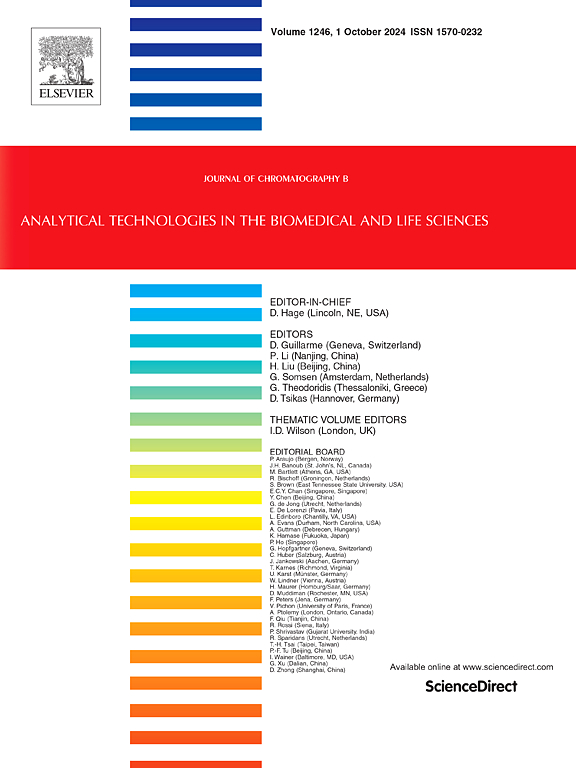Analysis, biology and significance of dimethylamine, trimethylamine and trimethylamine N-oxide in humans and in the marine ecosystem
IF 2.8
3区 医学
Q2 BIOCHEMICAL RESEARCH METHODS
引用次数: 0
Abstract
Dimethylamine (DMA) and its relatives including trimethylamine (TMA) and trimethylamine N-oxide (TMAO) are widely distributed in nature including humans and the marine ecosystem. This article gives an overview of the origin, occurrence, metabolism and potential functions of dimethylamine in human life and of the DMA-TMA-TMAO axis in the marine ecosystem. In humans, a dimethylamine fraction of about 80–90 % is of endogenous origin. The remaining 10–20 % is of exogenous origin, notably of foods and especially of certain fish and seafood. Several different analytical methods are available for the quantitative determination of dimethylamine, trimethylamine and trimethylamine N-oxide in biological samples including human urine and fish. Frequently used methods include GC-FID, GC-ECD, GC–MS and more recently LC-MS/MS. A widely used GC–MS method of dimethylamine in human urine includes its extractive derivatization with pentafluorobenzoyl chloride. The dimethylamine concentration in plasma and serum is of the oder of 3 μM in healthy humans and several times higher in humans suffering from chronic kidney diseases. The dimethylamine concentration in human urine may range between 100 μM and 1500 μM, corresponding to mean creatinine-corrected excretion rates of 10 to 80 μmol dimethylamine/mmol creatinine in adults and up to 400 μmol dimethylamine/mmol creatinine in children and adolescents. GC–MS methods have contributed greatly to a better understanding of the biology of dimethylamine in health and disease. In humans, up to 90 % of urinary dimethylamine is considered a measure of its endogenous synthesis from post-translational dimethylation of arginine residues in proteins. This abundant post-translational modification leads to asymmetrically dimethylated arginine proteins, which, upon regular proteolysis, generate asymmetrical dimethylarginine (ADMA) that is finally hydrolyzed to and L-citrulline and dimethylamine, which is then readily excreted in the urine. In fishery, dimethylamine and trimethylamine are discussed as indicators of freshness due to their enhanced production of microbiomal activity. High amounts of dimethylamine are found in canned fish. Dimethylamine is considered the precursor of the cancerogenic N-nitroso-dimethylamine. Other non-volatile amines such as histamine and agmatine seem to be better suitable as fish freshness indicators. High contents of the order of several mmol trimethylamine N-oxide per kg tissue are found in fish in dependence on the habitat depth. It is assumed that trimethylamine N-oxide act as osmolytic and piezolytic agent. The significance of trimethylamine N-oxide in human health and disease is elusive.

二甲胺、三甲胺和三甲胺n -氧化物在人类和海洋生态系统中的分析、生物学和意义
二甲胺(DMA)及其近亲,包括三甲胺(TMA)和三甲胺 N-氧化物(TMAO)广泛分布于自然界,包括人类和海洋生态系统。本文概述了二甲基胺在人类生活中的起源、发生、代谢和潜在功能,以及 DMA-TMA-TMAO 轴在海洋生态系统中的作用。在人类体内,约 80-90% 的二甲基胺来自内源性。剩余的 10-20% 来自外源,主要是食物,特别是某些鱼类和海产品。目前有几种不同的分析方法可用于定量检测包括人体尿液和鱼类在内的生物样本中的二甲胺、三甲胺和三甲胺 N-氧化物。常用的方法包括 GC-FID、GC-ECD、GC-MS 和最新的 LC-MS/MS。广泛使用的人体尿液中二甲基胺的 GC-MS 方法包括用五氟苯甲酰氯对其进行萃取衍生。健康人血浆和血清中的二甲胺浓度为 3 μM,而慢性肾病患者的二甲胺浓度则高出数倍。人体尿液中的二甲胺浓度介于 100 μM 和 1500 μM 之间,这与成人 10 至 80 μmol 二甲基胺/mmol 肌酐的平均肌酐校正排泄率以及儿童和青少年高达 400 μmol 二甲基胺/mmol 肌酐的平均肌酐校正排泄率相对应。气相色谱-质谱(GC-MS)方法大大有助于人们更好地了解二甲胺在健康和疾病中的生物学作用。在人类尿液中,高达 90% 的二甲胺被认为是蛋白质中精氨酸残基翻译后二甲基化产生的内源性合成物。这种丰富的翻译后修饰会导致精氨酸蛋白质发生不对称二甲基化,在正常的蛋白质分解过程中,会产生不对称二甲基精氨酸(ADMA),最后水解为 L-瓜氨酸和二甲胺,然后很容易随尿液排出体外。在渔业中,二甲胺和三甲胺被视为新鲜度的指标,因为它们能增强微生物的活性。罐头鱼中含有大量二甲胺。二甲胺被认为是致癌物质 N-亚硝基二甲胺的前体。组胺和γ-氨基丁酸等其他非挥发性胺类似乎更适合作为鱼类新鲜度指标。根据栖息地深度的不同,鱼类每千克组织中的三甲胺 N-氧化物含量很高,大约为几毫摩尔。据推测,三甲胺 N-氧化物具有渗透和压解作用。三甲胺 N-氧化物对人类健康和疾病的影响尚不明确。
本文章由计算机程序翻译,如有差异,请以英文原文为准。
求助全文
约1分钟内获得全文
求助全文
来源期刊

Journal of Chromatography B
医学-分析化学
CiteScore
5.60
自引率
3.30%
发文量
306
审稿时长
44 days
期刊介绍:
The Journal of Chromatography B publishes papers on developments in separation science relevant to biology and biomedical research including both fundamental advances and applications. Analytical techniques which may be considered include the various facets of chromatography, electrophoresis and related methods, affinity and immunoaffinity-based methodologies, hyphenated and other multi-dimensional techniques, and microanalytical approaches. The journal also considers articles reporting developments in sample preparation, detection techniques including mass spectrometry, and data handling and analysis.
Developments related to preparative separations for the isolation and purification of components of biological systems may be published, including chromatographic and electrophoretic methods, affinity separations, field flow fractionation and other preparative approaches.
Applications to the analysis of biological systems and samples will be considered when the analytical science contains a significant element of novelty, e.g. a new approach to the separation of a compound, novel combination of analytical techniques, or significantly improved analytical performance.
 求助内容:
求助内容: 应助结果提醒方式:
应助结果提醒方式:


